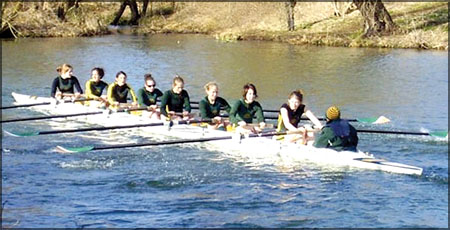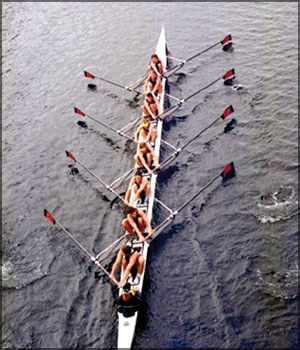Sport Track
A popular water sport - Row, row, row your boat
- Leslie Fernando - Senior sports writer
Rowing is a sport in which athletes race against each other on
rivers, lakes or on the ocean depending upon the type of race and
discipline. The boats are propelled by the reaction forces on the oar
blades as they are pushed against the water.
The sport can be both recreation, focusing on learning the techniques
required and competitive where overall fitness plays a large role. It is
also an Olympic sport. In the United States and Canada, high school and
collegiate rowing is sometimes referred to as crew.
The crew and their physical attributes

In all boats with the exception of single sculls, each rower is
numbered in sequential order; low numbers at the bow and the highest at
the stern. The person seated in the first seat is called the bowman or
just ‘Bow’ while the rower closest to the stern is called the
‘strokeman’ or just ‘stroke’. There are some exceptions to the rude.
UK coastal rows and those in France, Spain and Italy are numbered
from stern to bow. In addition to this, certain crew members have other
titles and role eight member. In a crew the stern pair are responsible
for setting the stroke rate and rhythm for the rest of the boat to
follow.
The middle four (sometimes called the ‘engine room’) are usually the
less technical, but more powerful rowers in the crew. The bow pair are
the more technical ones and are generally regarded as the pair to set up
the balance of the boat.
Competitive rowing favours tall, muscular athletes due to the
additional leverage height provides in pulling the oar through the water
as explosive power is needed to propel the boat at high speed.
Open or heavy weight rowers of both sexes tend to be very tall,
broad-shouldered, have long arms and legs as well as tremendous
cardiovascular capacity and very low body fat ratios.
Olympic or International level heavyweight male oarsmen are typically
anywhere between 6’3” and 6’9” (190 cm to 206 cm) in height with most
averaging around 6’6” (198 cm) and weighing approximately 225 lb (102
kg) with about 6 to 7 per cent body fat. Heavyweight women are slightly
shorter at around 6’1” (180 cm) and lighter than their male
counterparts.
How steering is done
Single and double sculls or oars are steered by the scullers pulling
harder on one side or the other. In other boats that are fitted with a
rudder, it is controlled by the cox, if present, or by one of the crew.
In the latter case, the rudder cable is attached to the toe area of one
of the crew members which can be pivoted about on the ball of the foot,
moving the cable left or right.
The steersman, who has the best vision when looking over his/her
shoulder may row at the bow. On straighter courses, stroke may steer,
since he or she can point the stern of the boat at some landmark at the
start of the course. On international courses, landmarks for steersman
consisting of toe aligned poles are provided.
Types of oars and their use
Oars are used to propel the boat. They are long (250-300 cm) poles
with one flat end and about 50 cm long and 25 cm wide, called the blade.
Classic oars were made out of wood, but modern oars are made from
synthetic material, the most common being carbon fibre. An oar is often
referred to as ‘blade’ in the case of sweep oar rowing and as a ‘scull’
in the case of sculling.
A sculling oar is shorter and has a smaller blade area than the
equivalent sweep oar. The combined blade area of a pair of sculls is
however greater than that of a single sweep oar, so the oarsman when
sculling is working against more water than when rowing sweep-oared. He
is able to do this because the body action in sculling is more
anatomically efficient.
Competitions and endurance

Rowers may take part in the sport for their own pleasure as a leisure
activity or row competitively. There are different types of competitions
in the sport of rowing. In the US all types of races are referred to as
‘regattas’ whereas this term is only used in UK for head-to-head races
which take place in the summer season. Time trials occur in the UK
during the winter and are referred to as Head races.
Rowing is an unusual sport going by the demands it places on
competitions. For example, the standard world championship race distance
of 2,000 metres is long enough to have a huge endurance element,
involved but short enough (typically 5.5 to 7.5 minutes) to make it seem
like a sprint.
This means that rowers have some of the highest power outputs of
athletes in any sport. Meanwhile, the motion of rowing involved in the
sport compresses the lungs of the rowing crew limiting the amount of
oxygen.
This requires the rowers to tailor their breathing to the stroke,
typically inhaling and exhaling twice per stroke, unlike in most other
sports such as cycling where competitors can breathe freely.
Birth of FISA
FISA stands for the Federation International des Docietes d’Aviron in
French. The English equivalent - International Federation of Rowing
Associations was founded by representatives from France, Switzerland,
Belgium, Adriatica (now a part of Italy) and Italy in Turin in June
1892.
It is the oldest international sports federation in the Olympic
movement.FISA first organised a European Rowing Championship in 1893. An
annual World Rowing Championship was introduced in 1962. Rowing has also
been conducted at the Olympic Games since 1900 (cancelled at the first
modern games in 1896 due to bad weather). |
